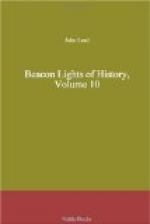“When peace was finally restored, the empire presented the aspect of a stable government, resting solidly upon the approval of a contented and thriving people.” This was the general opinion of those who were well acquainted with French affairs, and of those who visited Paris, which was then exceedingly prosperous. The city was filled with travellers, who came to see the glory of success. Great architectural improvements were then in progress, which gave employment to a vast number of men theretofore leading a precarious life. The chief of these were the new boulevards, constructed with immense expense,—those magnificent but gloomy streets, which, lined with palaces and hotels, excited universal admiration,—a wise expenditure on the whole, which promoted both beauty and convenience, although to construct them a quarter of the city was demolished. The Grand Opera-House arose over the debris of the demolished houses,—the most magnificent theatre erected in modern times. Paris presented a spectacle of perpetual fetes, reviews of troops, and illuminations, which both amused and distracted the people. The Louvre was joined to the Tuileries by a grand gallery devoted chiefly to works of art. The Champs Elysees and the Bois de Boulogne were ornamented with new avenues, fountains, gardens, flowers, and trees, where the people could pursue their pleasure unobstructed. The number of beautiful equipages was vastly increased, and everything indicated wealth and prosperity. The military was wisely kept out of sight, except on great occasions, so that the people should not be reminded of their loss of liberties; the police were courteous and obliging, and interfered with no pleasures and no ordinary pursuits; the shops blazed with every conceivable attraction; the fashionable churches were crowded with worshippers and strangers to hear music which rivalled that of the opera; the priests, in their ecclesiastical uniform, were seen in every street




